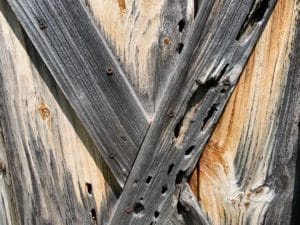Hello fellow Readers,
Spring is a busy time for folks in the horticultural industry – Spring Madness Mode, I call it, and it’s hard to keep up. It’s also a busy time for wildlife. Birds are flitting about to find their best spots. It’s fun to anticipate new baby birds. But we don’t feel the same about all critters, do we? Like all the carpenters buzzing about – Eastern Carpenter Bees, that is. But they are essential pollinators.

Carpenter Bee damage often couples with Woodpecker damage.
Please don’t hold their carpentry against them.
Xylocopa virginica, the most common species of carpenter bees, is wreaking havoc on the barn, not because of their yen to eat wood. Rather, they’re nesting. Please don’t hold their carpentry against them; they are pollinators in a world where they are drastically declining.
The other day while getting dressed, a carpenter bee hovered by my window as though staring at me. Curt treated the barn to prevent further damage from their nesting, so I thought he was angry. I felt sad for him, but carpenter bees cause significant damage. Plus, there are other places to nest.
The fascinating breeding cycle of Carpenter Bees
The sawdust explosions are from carpenter bees emerging from their tunnels called galleries. They overwinter there, and surface come spring to mate. Then the females gather nectar and return to build a pollen plug in a gallery chamber to lay eggs. She’ll lay one egg per chamber, often boring new tunnels in the gallery to accommodate her six to ten eggs before closing the tunnel with wood chips for her baby’s protection. Then the mom bee dies. In three months, her larvae become adults who often return to the same gallery to overwinter. That’s when you’ll see woodpeckers pecking for lunch.

Carpenter Bee (Xylocopa virginica) photo by Daniel Schwen [CC BY-SA 4.0 (https://creativecommons.org/licenses/by-sa/4.0)]
Like most things, the best defense is prevention.
Seal crevices along your foundation and walls with caulk. Carpenter bees prefer unpainted wood in areas that get the morning sun. So, keeping up with deck maintenance is a deterrent, though oil or latex paint is a better restraint than deck stain.
Only plug entry holes (about a half-inch in size) in the early fall before the bees return to the gallery. If you fill the holes too soon, they’ll drill a new hole, and you’ll have an explosion of sawdust. Using wood putty is best if you plan to paint.
Insecticides can help repel them from starting a new tunnel on the surface, but it only lasts until the rain washes it off and won’t kill those in the galleries. That’s where insecticidal dust comes in, which you can pump into the tunnels.
Pyrethrin, a natural insecticide, is safer than chemicals.
As you would guess, I’m concerned about using chemicals. Even pyrethrin, a natural insecticide derived from chrysanthemums, is toxic to pollinators such as carpenter bees. Given the circumstances, an organic approach is safer when appropriately applied when pollinators are inactive –in the early morning or late evening. Besides, deterring them from tunneling our barn will encourage them to reside in downed trees or old logs where they belong.

Race Farm Market, Blairstown, NJ Carpenter Bee Deterrent

A fun side note:
I went to our local Races Farm Market, and carpenter bees were bombarding the entrance. Devin showed me a decoy wasp nest made out of a crunched-up brown bag someone had suggested. “Why not give it a try?” She said. “There seems to be less of them.”
The next day I returned to take a photo of the decoy to share with you, and the carpenter bees were idle. After snagging a few pictures, one lone carpenter bee flew by. He was a mild-mannered little guy. I rather enjoyed him, although I couldn’t get a clear shot. It just goes to show the power of movement and the power of pollinators. Think of carpenter bees are our friends rather than foes.
Maybe that lone carpenter bee was feeling the same stress as I – so much to do in spring – so little time. Why not shift to so many joyous things to do in spring, with plenty of time to play? Better.
Garden Dilemmas? AskMaryStone@gmail.com and your favorite Podcast App.
There’s much more to the story in the Garden Dilemmas Podcast:
Other ways to deter Carpenter Bees per Homes and Gardens
The related story you’ll enjoy – Giving Thanks


